Don’t get exotic goldfish for your pond, get indigenous Banded Tilapia, was the advice. And so we did.
We tracked down a small business on a smallholding that bred goldfish for the pet trade, and also bred Banded Tilapia (Tilapia sparrmanii) on the side. We went home with a plastic bag half-filled with pond water in which swam 12 tiny Banded Tilapia small fry – each fish about 1 cm long. We floated the bag, knotted at the top, on the surface of our pond so that the temperature of the water in the bag would equalise with the temperature of the water in the pond. After several hours, we undid the knot and released the tiny fish into the pond, and they quickly disappeared under the water plants.
For weeks we would visit the pond hoping to spot one of the tiny fish and didn’t see any. They must all have died, we thought, until eventually one day we saw one, and then another and another. By now the tiny fish had grown to about 3 cm in length. So, our pond had a population of healthy little fish after all!
We had decided to get the fish for the pond in the hope that they would eat algae and also mosquito larvae. Banded Tilapia are mostly vegetarian and they are often used as a biological control of invasive water plants such as duck weed, but the juveniles also eat small crustaceans and midge larvae, and we think that they also eat mosquito larvae (the larger Nile Tilapia definitely do).
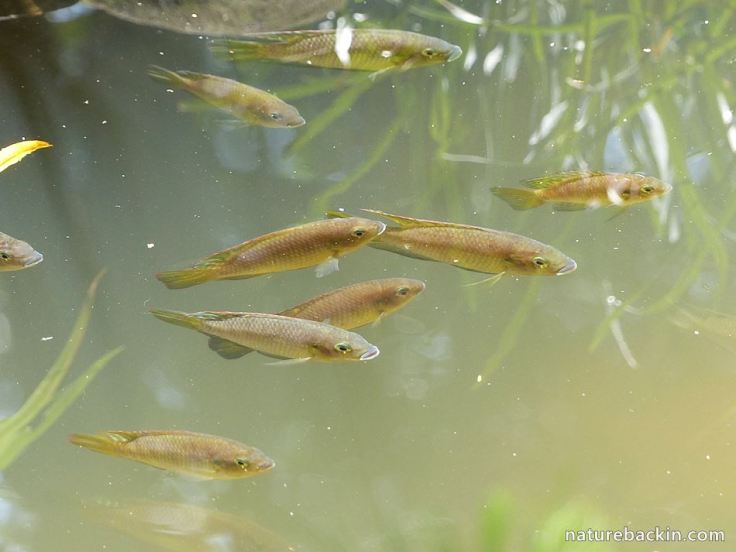
Banded Tilapia are beautiful little fish, with their colour varying with the seasons
One would think that Banded Tilapia are perfectly suited to garden ponds as they are relatively small. In ideal conditions they can grow to a maximum of about 23 cm in length. The fish in our pond were really good at eating algae growing on underwater surfaces, and they also nibbled on many of the water plants too, as well as some plants growing outside the pond that trailed into the water.
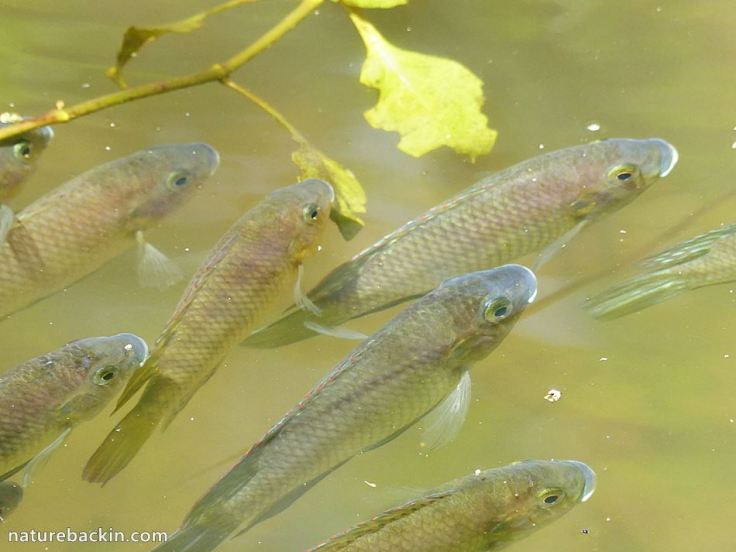
When we discovered that the Banded Tilapia enjoyed a forest margin plant, Clinging Aneilema (Aneilema aequinoctiale), when it trailed into the pond, we would sometimes float clippings of this plant on the surface of the water for them to nibble on
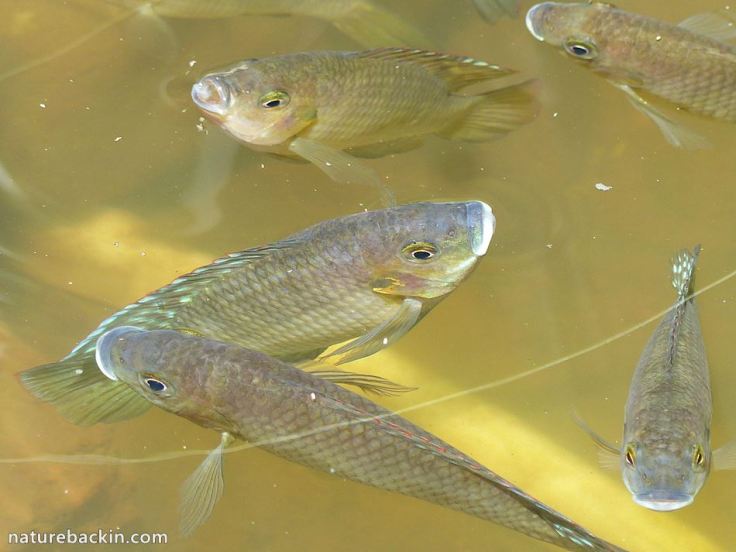
The spines in the dorsal fins of the Banded Tilapia can be quite sharp. At times the fins have an iridescent green sheen as can be seen in this photo
What we didn’t know about Banded Tilapia is that they are extraordinarily prolific breeders. Like most fish in the cichlid family, Banded Tilapia are very good parents. In the wild they undertake seasonal upstream migrations and breed before and during these migrations. In our pond, they seemed to breed often during the summer, being relatively dormant during the winter when they would seemingly hibernate in the deep water, often under rocky shelters, at the bottom of the pond.
When breeding, the bands or stripes on both the male and the female become darker. The male builds a nest in floating vegetation to which he attracts a potential mate. She lays her eggs in the nest and the male then fertilises the eggs. The pair of them guard the nest and also the small fry once they have hatched.
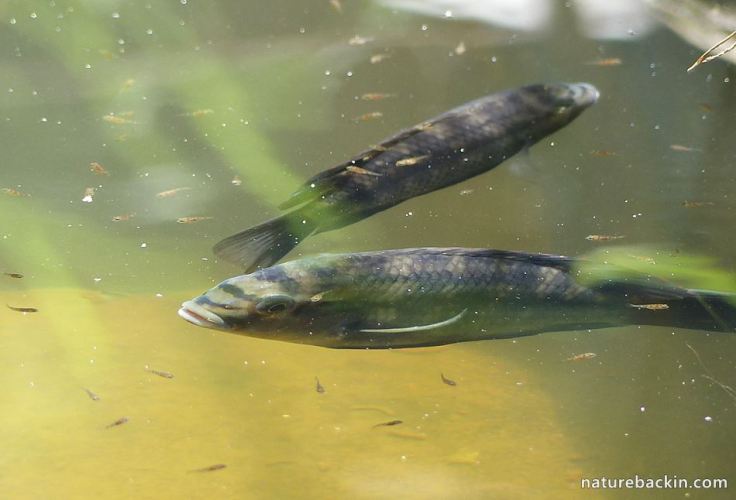
A breeding pair of Banded Tilapia in our pond surrounded by their very tiny babies that they guard tenaciously. The female is slightly larger than the male. Some cichlids are mouth brooders. The Banded Tilapia are not, but they may use their mouths to move their young to a different site while they are hatching
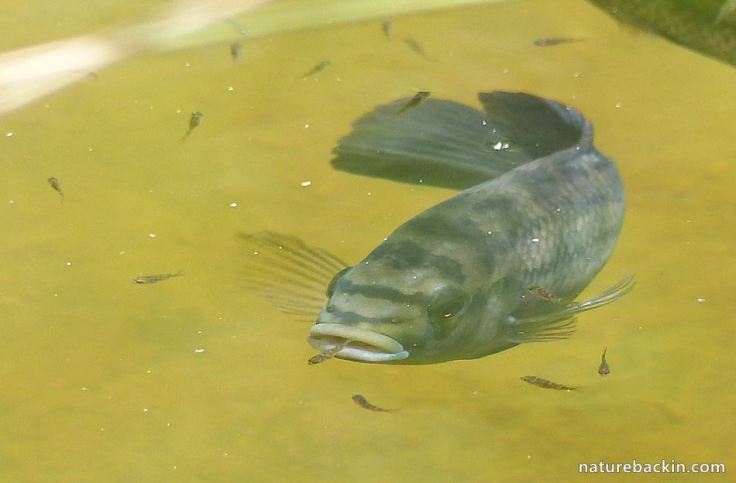
One of the parents showing off its breeding stripes while guarding its young
So, being such good parents and with few predators of fish in our pond, our 12 tilapia multiplied and multiplied. After a few years our initial pond sprung a leak (more on this in a future post) and we built a small second interlinked dormitory pond where we could place the fish while the first pond was repaired. To move the fish to the second pond we caught them by hand using small homemade fishing nets. It was while catching and moving the fish that we discovered how spiny their dorsal fins are!
As we caught and moved the fish we tried to keep count and we lost count once we got to about 200! This was far too many fish for the small pond. We tried giving some away to friends with ponds, but that did not reduce the numbers significantly. The high number of fish did mean that some of water plants were completely eaten, with some even being pulled out of their pots, but the main adverse result was that the water became too nutrient rich with so many fish excreting their waste into the pond. The end result was algae overload. We also found that the metal in the pond pump was constantly corroding indicating also that the fish waste was making the water very acidic.
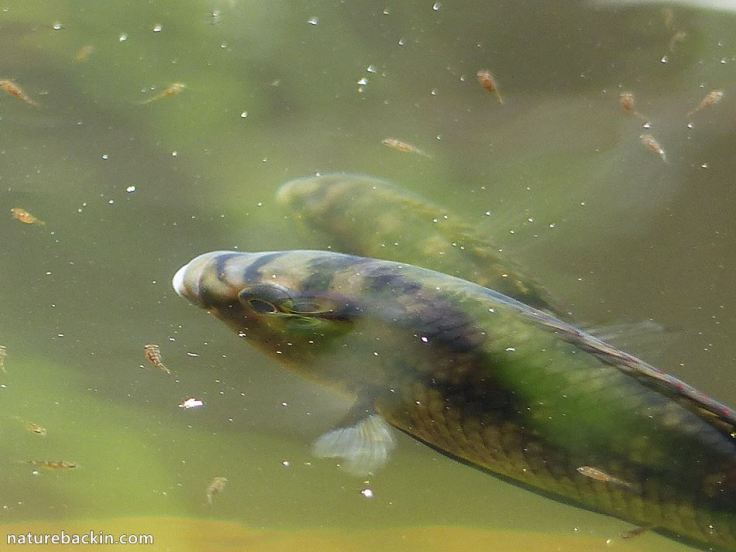
Tiny tilapia guarded by their conscientious parents
So in the end we decided that it would be best and perhaps kindest to release the fish into the wild. We contacted a local conservationist with specialist knowledge of indigenous freshwater fish for advice. He said we should not release them into a dam as they breed so prolifically; rather release them into one of the nearby tributaries leading to the main river in the region. So we scouted around for an area that did not seem too polluted, and in an assortment of buckets and plastic bags took our fish there and released them into the stream. They swam off at speed without a backward glance, perhaps better off outside the confines of the pond. I have to say though that we do miss them, although the quality of the pond water is much better off without them.
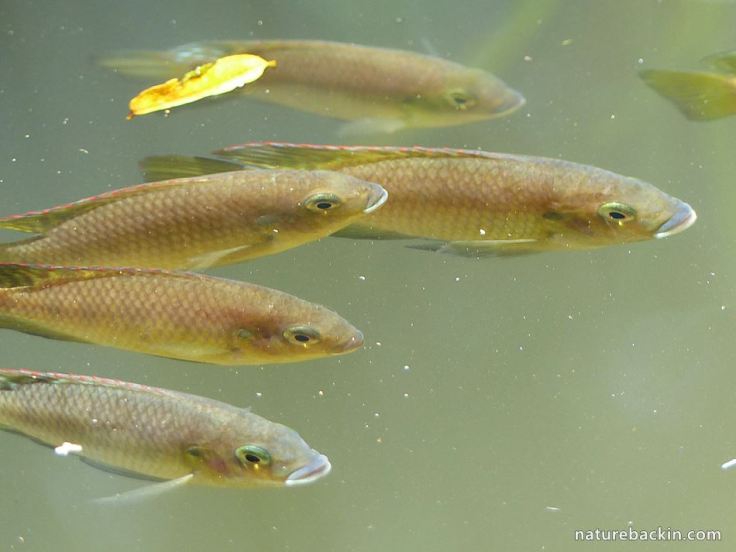
Source: Tilapia sparrmanii. IUCN Red List of Threatened Species. http://www.iucnredlist.org/details/181777/0
Posted by Carol

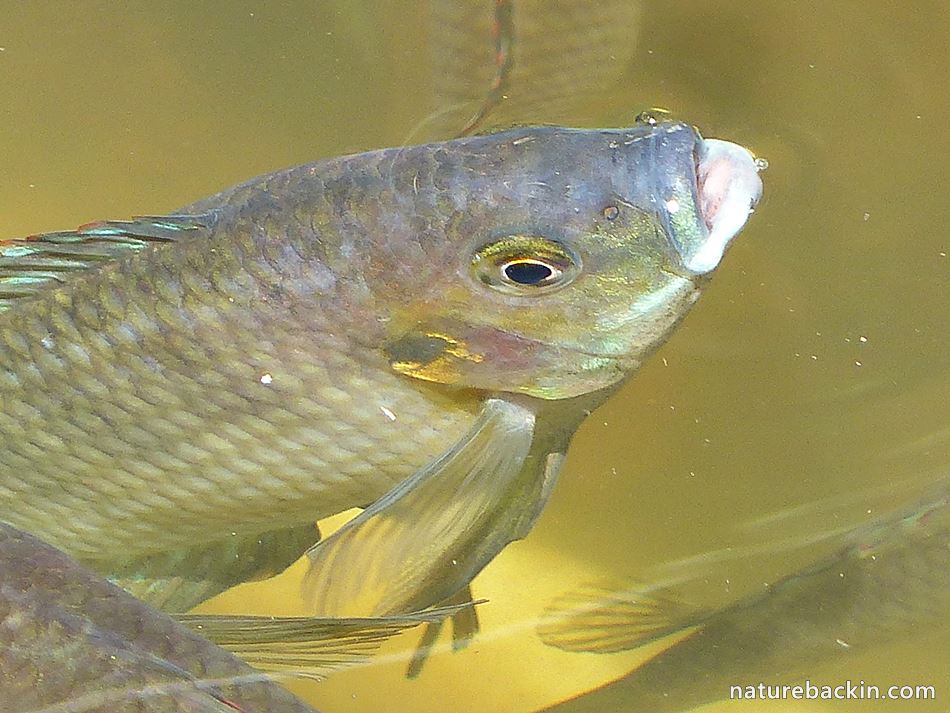







May 18, 2019 at 9:48 am
Most interesting read! I came across the banded tilapia when looking for a species for my aquaponics system. I happily got Mozambique tilapia because they can tolerate lower temperatures then the Nile variety. No problem with tolerating the temperatures in my system – but I wasn’t aware they go into hibernation when temperature reaches about 16 degree. Which obviously defeats the object when running an aquaponics system – I need them to produce the fertilizer….Trout did well for a while until the power supply to the green house was interrupted without my knowledge and aeration stopped for long enough to kill them all…. Since the banded tilapia can tolerate even lower temperatures than the Mozambique, I thought they may as well hibernate at a lower temperature range? But I can’t find any information online… Do you know anything about this topic? Any hint would be much appreciated…
LikeLiked by 1 person
May 21, 2019 at 8:17 pm
Sorry that you lost the trout due to a power supply interruption. The hibernation issue is an interesting problem for aquaponics – something I was not aware of before.. All I can tell you is that the banded tilapia hibernated here once nighttime temperatures dropped to about 9 degrees or less even though the days here are relatively warm. We recall reading some time back (can’t remember where) that banded tilapia hibernate once the water temp drops to 11 degrees but I don’t know how reliable this info is. Once in hibernation they remain dormant until the water temperature rises significantly and consistently over a period of time. Sorry not to be able to offer more information. Good luck with your project.
LikeLike
March 8, 2018 at 7:30 pm
Hey Carol, how do you manage to tell all these excellent animal(f)ish tales of creatures with tails. Again excellent photos.
LikeLiked by 1 person
March 8, 2018 at 9:58 pm
Thanks Abrie 🙂
LikeLiked by 1 person
February 27, 2018 at 12:42 pm
A fascinating story Carol. From the sounds of it you managed to catch all the fish, even the tiny ones. Gorgeous photos as ever 🙂
LikeLiked by 1 person
March 2, 2018 at 6:36 am
Thanks Sandra. Fortuitously, when we had to move the fish it was not in breeding season so there were no small fry to catch.
LikeLiked by 1 person
February 26, 2018 at 3:57 pm
Fascinating! It is so difficult to balance the ecology of small ponds, especially with fish. My brother is an aquatic horticulturalist and has several small ponds in his own yard. A Great Blue Heron decided to become a regular visitor, which ended his custom of keeping any fish outdoors…but they were so lovely before that!
LikeLiked by 1 person
March 2, 2018 at 6:35 am
With our prolific tilapia, any herons or other predatory birds would have been very welcome 🙂
LikeLiked by 1 person
March 6, 2018 at 4:19 pm
It’s too bad I couldn’t give them the message! The herons continue to check back on the ponds, and do manage to keep the frog population down, a group that rather happily introduced themselves.
LikeLiked by 1 person
March 7, 2018 at 7:45 pm
🙂
LikeLike
February 24, 2018 at 4:38 am
An enchanting read and I love the photos!
LikeLiked by 1 person
February 25, 2018 at 3:33 pm
Thanks so much. I thought this might be a rather inconsequential tale, even though it taught us quite a lot!
LikeLiked by 1 person
February 23, 2018 at 9:56 am
If more people took the time to research thoroughly and were humble enough to take advice, so many of the issues with abandonment and cruelty to creatures would be prevented. As ever this was a fascinating (and wise) read.
LikeLiked by 1 person
February 25, 2018 at 3:30 pm
Thank you Osyth. I am touched that people have been interested in, and even commented on, our rather fumbling experience with these creatures.
LikeLiked by 1 person
February 25, 2018 at 4:51 pm
I think you are more of a beacon than you give yourself credit for …
LikeLiked by 2 people
February 23, 2018 at 4:23 am
What a fascinating post.
LikeLiked by 2 people
February 25, 2018 at 2:25 pm
Thanks so much, Anne.
LikeLike
February 23, 2018 at 2:33 am
I wonder if a pair of kingfishers staked a claim to your pond, whether that would’ve had a controlling effect on the population?
LikeLiked by 1 person
February 25, 2018 at 2:24 pm
Perhaps! The only kingfisher to visit our garden is the Brown-headed Kingfisher that prefers to catch insects.
LikeLike
February 22, 2018 at 9:41 pm
Good job. You researched and did the best thing.
LikeLiked by 1 person
February 23, 2018 at 6:41 am
Thanks Sherry. It was a learning process for us.
LikeLike
February 22, 2018 at 8:56 pm
Fascinating. I would have expected them to regulate their numbers to a sustainable one. Without your intervention, they’d all eventually have died, wouldn’t they?
LikeLiked by 1 person
February 23, 2018 at 6:40 am
Or at least enough would die to bring the numbers down. A rather smelly process that would be though. Not ever having done any fishing I was surprised when handling live fish to find that they smell exactly the same as dead fish seen at fish markets. I suppose it is in the oils that they secrete.
LikeLiked by 1 person
February 22, 2018 at 8:53 pm
Definitely too much of a good thing! I gave up on having fish in my little pond, too, because it is so challenging to get the balance right and keep clean. Now it’s just plants.
LikeLiked by 1 person
February 23, 2018 at 6:30 am
Yes, plants and tadpoles, freshwater snails and many other tiny creatures too. Interesting that you also found similar challenges with fish in the pond.
LikeLiked by 1 person